#luise rainer won an academy award for her performance in that film
Text
huh. did you know that as a lot of los angeles’s original chinatown was demolished to make room for union station in the late 40s, christine sterling, who had previously designed olvera street, decided to make a replacement called china city using sets from the hollywood film the good earth (1937)
#the good earth which starred an austro-hungarian actor and a german actress as its two chinese main characters#luise rainer won an academy award for her performance in that film#probably should check it out at some point#anyways this chapter in my book is going to be a los angeles-based gumshoe detective neonoir drama so that means doing research into#what the city was like in the mid 20th century#wasn't great!#ryddles
0 notes
Text
The Oscar Effect on Careers By Susan King
Does winning an acting Oscar change the career of the recipient? The answer is yes and also no. Take Brad Pitt, who won Best Supporting Actor last year for ONCE UPON A TIME IN HOLLYWOOD (2019). He’s a veteran superstar with over three decades in Hollywood. So, the award is more icing on the cake for his career. But that wasn’t the case when he earned his first nomination for Terry Gilliam’s 12 MONKEYS (‘95). Pitt was on a hot streak since gaining attention for his roles in THELMA & LOUISE (‘91), A RIVER RUNS THROUGH IT (‘92), INTERVIEW WITH THE VAMPIRE (‘94) and LEGENDS OF THE FALL (‘94), and his first Oscar nominations gave his career an even bigger boost.
Similar to Pitt, many young actors discovered their stock in Hollywood with Oscar gold, but nominations and wins have effected various stars’ careers in different ways. Here’s a look at various Oscar winners and how the award affected their careers.
Martin Landau

The Oscar has changed the career trajectory of many veteran actors. Martin Landau was making such TV movies The Harlem Globetrotters on Gilligan’s Island (’81) that just squandered his talents. But that all changed when he earned his first Oscar nomination for Francis Ford Coppola’s TUCKER: THE MAN AND HIS DREAM (’88), followed by a second for Woody Allen’s CRIMES & MISDEMEANORS (’89), eventually winning for his poignant performance as Bela Lugosi in Tim Burton’s ED WOOD (’94).
Ironically, Landau told me in a 2010 L.A. Times interview he didn’t think he could play the Dracula star. “It’s a Hungarian morphine addict, alcoholic who has mood swings,” he remembered telling Burton. “That would be hard enough, but it has to be Bela Lugosi! I said I don’t know if I can do this, but let’s do some tests.”
Makeup artist Rick Baker transformed Landau into the elderly frail actor. Burton, he recalled, looked at the tests and thought he was 50% Lugosi. Landau believed he captured the icon in fleeting moments. “I said if I can do it 10% of the time, I can do it 100% of the time. They have to accept me as Lugosi in the first five minutes or we don’t have a film. It was not an impersonation for me. He had to be a human being.”
Melvyn Douglas

Similarly, Melvyn Douglas, who was best known for his comedic roles in the 1930s and ‘40s in such films as NINOTCHKA (’39), had seen his career slow in the 1950s because of his liberal political leanings. But he came back to the forefront in 1960 after winning a Tony Award for Gore Vidal’s THE BEST MAN, and then receiving his first of two supporting actor Oscars for his turn as Paul Newman’s hard-working Texas rancher father in Martin Ritt’s HUD (’63). Seven years later, he received a Best Actor nomination as Gene Hackman’s father in I NEVER SANG FOR MY FATHER (’70), ultimately winning his second Oscar as the president of the United States in Hal Ashby’s BEING THERE (’79).
Luise Rainer

The German stage actress was signed to an MGM contract in the mid-30s. But the free-spirited Rainer, who considered herself an actress and not a movie star, was always at logger heads with studio head Louis B. Mayer. She told me in a 2011 L.A. Times interview, Mayer “couldn’t make me out. You know it was a little bit difficult for him. I wasn’t the type that he was used to. So, the poor man didn’t know what to do with me. For my first film, ESCAPADE [‘35], William Powell said [to him] you got to star that girl…My first film made me a star.”
Rainer won Best Actress as famed performer Anna Held in THE GREAT ZIEGFELD (’36) and as a Chinese peasant in THE GOOD EARTH (’37). All but one of her subsequent films didn’t do well at the box office and she left Hollywood. She made one film, HOSTAGES (’43), guest starred on some TV series including a voyage on The Love Boat and had a small part in indie film THE GAMBLER (’97).
Art Carney

One of the greatest comedic actors, Carney came to fame in the Honeymooners sketches on The Jackie Gleason Show and The Honeymooners series as Ralph Kramden’s (Gleason) best pal, the clueless sewer worker Ed Norton. He won five Emmys for his work with Gleason. Carney also originated the role of neatnik Felix Ungar opposite Walter Matthau’s Oscar Madison in the 1965 Broadway production of Neil Simon’s The Odd Couple.
Well-known that he had a drinking problem, Carney wasn’t working that much in film or TV in the late 1960s and early 1970s. In fact, he tried to convince Paul Mazursky he wasn’t right for the filmmaker’s heartfelt dramedy HARRY & TONTO (’74) about a curmudgeonly old New Yorker who travels with his cat across country after he loses his apartment. Mazursky told me in a 2011 L.A. Times interview that no one wanted the part. James Cagney, Laurence Olivier, Cary Grant and even Danny Kaye were among those who turned him down.
He had seen Carney on Broadway in 1957 in a dramatic role in The Rope Dancers. “Of course, I had seen him in The Honeymooners. He didn’t want to do it,” noted Mazursky. “He said ‘I’m 59 years old and you want this guy to be in his 70s.’ I said, ‘Art, this is the first time I met you and you look like you are in your 70s – you’re balding, you wear a hearing aid and you have a bum leg.’ He told me, ‘You don’t want me, I’m an alcoholic.’ He had one bad night then nothing else. He had been out on a binge and he showed up on location in Chicago in a taxi in the morning loaded. I took him up to his room, put him in the shower and made him a pot of coffee. He was easy to direct.”
Carney won both the Golden Globe and the Academy Award for his turn, beating out the likes of Jack Nicholson for CHINATOWN and Al Pacino for THE GODFATHER PART II. And he did some of his best work post-Harry including as an aging Los Angeles private detective in the charming THE LATE SHOW (’77) and as a senior who teams up with his buddies (George Burns and Lee Strasberg) to rob a bank in GOING IN STYLE (’79). He earned his sixth Emmy for the TV movie Terrible Joe Moran (’84), which was James Cagney’s last film. Carney’s final film was the 1993 Arnold Schwarzenegger disaster LAST ACTION HERO. “I’m outta here” was the last line Carney ever uttered on film.
59 notes
·
View notes
Photo
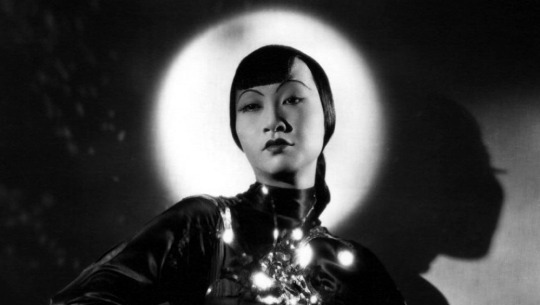

𝑮𝒆𝒎𝒎𝒂 𝑪𝒉𝒂𝒏 𝒂𝒔 𝑨𝒏𝒏𝒂 𝑴𝒂𝒚 𝑾𝒐𝒏𝒈.
Gemma Chan, film producers Nina Yang Bongiovi and Zhang Yingyue are teaming with Working Title Films and ZYY Studio to develop a biopic of Anna May Wong, the golden age icon whose career brought her international recognition even as she continued to face opportunity limitations in the industry and other forms of prejudice and discrimination. David Henry Hwang, the first Asian American playwright to win a Tony (in 1988 for M. Butterfly), is penning the screenplay, adapted from Graham Russell Gao Hodges’ 2012 biography, Anna May Wong: From Laundryman’s Daughter to Hollywood Legend. Wong’s niece Anna Wong is serving as a consultant on the film.
“Anna May Wong was a trailblazer, an icon and a woman ahead of her time,” said Chan in a statement. “Her talent and her exploration of her art both in and outside of the U.S. was groundbreaking — and the challenges and prejudice she faced in the early 20th century as an actress speak directly to the conversations and the world we are navigating today.”
“I’m delighted that I’ll get to build on my aunt’s legacy with Gemma and Nina, who are Asian leaders in the forefront of storytelling,” Anna Wong said in a statement. “Anna May Wong’s presence in American and worldwide cinema was the first of its kind, and her representation continues to resonate today. She is the embodiment of inspiration for artists of color.”
Anna May Wong was born in Los Angeles in 1905 and appeared in 60 films between 1919 and 1960. Her career began in the silent era (including 1924’s The Thief of Bagdad starring Douglas Fairbanks and 1929’s Piccadilly) and continued as films began to adopt sound, such as 1932’s Shanghai Express, in which she starred alongside Marlene Dietrich. Despite her filmography and status as a fashion icon, MGM refused to consider her for the female lead of its 1937 adaptation of Pearl S. Buck’s The Good Earth, about a Chinese family. O-Lan instead was played by white German actress Luise Rainer, who won the Academy Award for best actress for the role.
When Hollywood restricted her options, Wong went abroad, performing onstage in Europe and dedicating herself to documenting Chinese stories during World War II. She returned to the screen in 1951 to star in The Gallery of Madame Liu-Tsong, the first American television series to feature an Asian American lead, and continued to act until her sudden death of a heart attack in 1961, at the age of 56.
Wong’s legacy has been memorialized in recent years. In 2020, Michelle Krusiec (Saving Face) portrayed the pioneer in Ryan Murphy’s alternate history drama Hollywood on Netflix, and last year the U.S. Mint announced that Wong will be featured in its American Women quarters series, which will make her the first Asian American to appear on U.S. currency. The Working Title biopic is slated to be the cinema icon’s biggest cultural tribute yet.
Chan is represented by M88, the U.K.’s Independent and WME. Hwang is repped by CAA and Schreck Rose. Zhang is repped by CAA and her own independent film company.
2 notes
·
View notes
Text
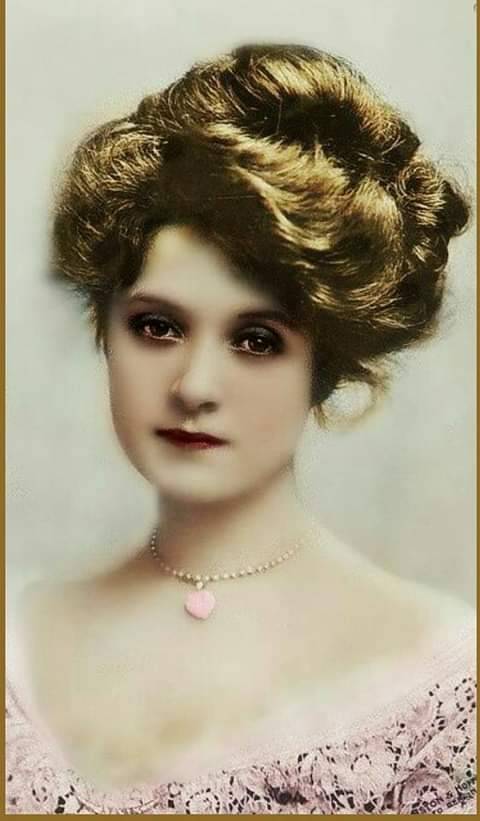
Mary William Ethelbert Appleton "Billie" Burke (August 7, 1884 – May 14, 1970) was an American actress, famous on Broadway and in early silent film and subsequently in sound film, best known to modern audiences as Glinda the Good Witch of the North in the movie musical The Wizard of Oz. She was nominated for the Academy Award for Best Supporting Actress in 1938 for her performance as Emily Kilbourne in Merrily We Live and is also remembered for her appearances in the Topper series. Billie Burke was the wife of Broadway producer Florenz Ziegfeld, Jr., of Ziegfeld Follies fame, from 1914 until his death in 1932. Her voice was unique in intonation, which she accentuated in her later character roles as dim-witted, spoiled society types.
Billie Burke was born Mary Burke, the daughter of William "Billy" Burke and Blanche (née Beatty 1844–1921), in Washington, D.C. She toured the United States and Europe with her father, who was a singer and clown and worked for the Barnum & Bailey Circus. Her family ultimately settled in London where she attended plays in the West End. In 1903, she began acting on stage, making her debut in London in The School Girl. Other London shows included The Duchess of Dantzic (1903) and The Blue Moon(1904). She eventually returned to America to star in Broadway musical comedies.
Early life
Career
Burke went on to play leads on Broadway in Mrs. Dot, Suzanne,The Runaway, The "Mind-the-Paint" Girl, and The Land of Promise from 1910 to 1913, along with a supporting role in the revival of Sir Arthur Wing Pinero's The Amazons. There she caught the eye of producer Florenz Ziegfeld, marrying him in 1914. Two years later they had a daughter, Patricia Ziegfeld Stephenson (1916–2008).
Billie Burke in the Broadway production of Arthur Wing Pinero's The "Mind the Paint" Girl (1912).
The actress's beauty and taste made her a major trendsetter throughout the 1910s and 20s. Much of her wardrobe, on screen and off, at this time was provided by the leading European couturier Lucile (in private life Lady Duff Gordon), whose New York branch was then the fashion mecca for socialites and entertainment celebrities.
Burke was signed for the movies, making her cinematic debut in the title role of Peggy (1915). Her success was phenomenal, and she was soon earning what was reputedly the highest salary granted a motion picture actress up to that time. She followed her first feature with the 15-part serial Gloria's Romance (1916), another popular and critically acclaimed vehicle. By 1917 Billie Burke was a favorite with silent movie fans, rivaling Mary Pickford, Lillian Gish,Clara Kimball Young and Irene Castle. Billie Burke starred primarily in provocative society dramas and comedies, similar in theme to The "Mind-the-Paint" Girl, her most successful American play. The star's girlish charm rivaled her acting ability, and as she dressed to the hilt in fashionable gowns, furs and jewelry, her clothes sense also won the devotion of female audiences. Among the films in which she appeared during this period were Arms and the Girl(1917), The Mysterious Miss Terry,Let's Get a Divorce (1918), Good Gracious, Annabelle (1919), Away Goes Prudence (1920) and The Frisky Mrs. Johnson (1920).
In 1933, Burke was cast as Millicent Jordan, a scatterbrained high-society woman hosting a dinner party in the comedy Dinner at Eight, directed by George Cukor, co-starring with Lionel Barrymore, Marie Dressler, John Barrymore, Jean Harlow and Wallace Beery. The movie was a great success, and revived her career. She subsequently starred in many comedies and musicals, typecast as a ditzy, fluffy and feather-brained upper-class matron with her high-pitched voice.
In 1936, MGM filmed a sanitized biopic of Florenz Ziegfeld (The Great Ziegfeld), a film that won Academy Awards for Best Picture and Best Actress (Luise Rainer as Ziegfeld's common-law wife, Anna Held). William Powell played Flo Ziegfeld and Myrna Loy played Burke, which infuriated Burke because she was under contract to the studio and could have played herself, but MGM considered her too old to cast in the part despite her obviously having the look and mannerisms down perfectly otherwise.
Despite her success in film, Billie Burke eventually returned to the stage, appearing in Caesar's Wife (1919), The Intimate Strangers (1921), The Marquise (1927) and The Happy Husband (1928). But when the family's savings were wiped out in the Wall Street Crash of 1929, she took up screen acting again to aid her husband.
In 1937 Burke appeared in the first of the Topper films, about a man haunted by two socialite ghosts (played by Cary Grant and Constance Bennett), in which she played the twittering and daffy Clara Topper. Her performance as Emily Kilbourne in Merrily We Live (1938) resulted in her only Oscar nomination. In 1938 she was chosen to play Glinda the Good Witch of the North, in the musical The Wizard of Oz (1939), directed by Victor Fleming, with Judy Garland. She had worked on a Garland film, Everybody Sing, in which she played Judy's histrionically hysterical actress-mother. Another successful film series followed withFather of the Bride (1950) and Father's Little Dividend (1951), both directed by Vincente Minnelli and starring Spencer Tracy, Joan Bennett, and Elizabeth Taylor.
Burke wrote two autobiographies, both with Cameron Van Shippe, With a Feather on My Nose (Appleton 1949) and With Powder on My Nose (Coward McCann, 1959).
Radio and television
In 1932, Burke made her Hollywood comeback, starring as Margaret Fairfield in A Bill of Divorcement, directed by George Cukor. (She played Katharine Hepburn's mother in the film, which was Hepburn's debut). Despite the death of Florenz Ziegfeld during the film's production, she resumed filming shortly after his funeral.
Burke joined the cast ofEddie Cantor's radio show in 1948
On CBS Radio, The Billie Burke Show was heard on Saturday mornings from April 3, 1943 until September 21, 1946. Sponsored by Listerine, this situation comedy was initially titled Fashions in Rations during its first year. Portraying herself as a featherbrained Good Samaritan who lived "in the little white house on Sunnyview Lane," she always offered a helping hand to those in her neighborhood. She worked often in early television, appearing in the short-lived sitcom Doc Corkle (1952). She was a guest star on several TV and radio series, including Duffy's Tavern.
On television, Burke starred in her own talk show, At Home With Billie Burke, which ran on the DuMont Television Network from June 1951 through the spring of 1952. She was one of the first female talk show hosts, after the hostesses of the earlier DuMont series And Everything Nice (1949–50) and Fashions on Parade (1948–49) which both included some talk show segments.
Burke tried to make a comeback on the New York stage. She starred in two short-lived productions: This Rock and Mrs. January and Mr. X. Although she got good reviews, the plays did not. She appeared in several plays in California as well, although her mind became clouded, and she had trouble remembering lines. In the late 1950s, her failing memory led to her retirement from show business, although her explanation for that was, "Acting just wasn't any fun anymore."
Burke's last screen appearance was in Sergeant Rutledge (1960), a Western directed by John Ford.
Source - Wikipedia
@ceeceerae
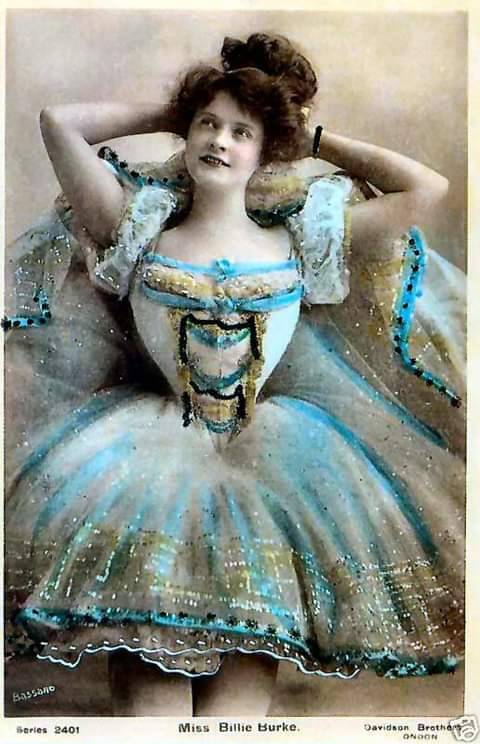
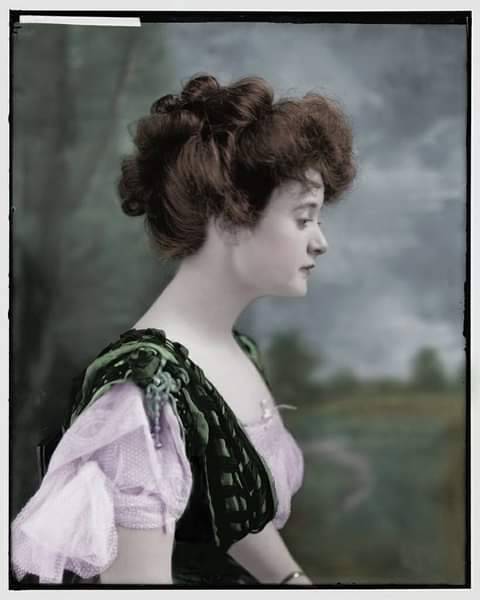

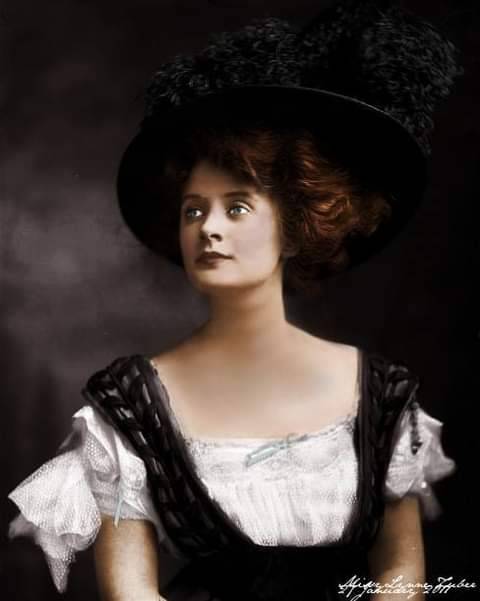
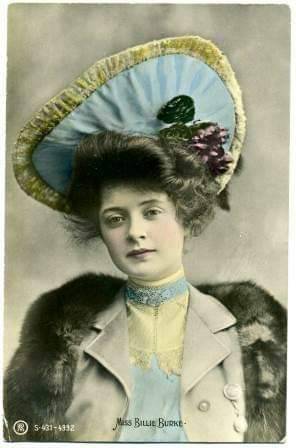


45 notes
·
View notes
Text

Janet Gaynor (born Laura Augusta Gainor; October 6, 1906 – September 14, 1984) was an American film, stage and television actress and painter.
Gaynor began her career as an extra in shorts and silent films. After signing with Fox Film Corporation (later 20th Century-Fox) in 1926, she rose to fame and became one of the biggest box office draws of the era. In 1929, she was the first winner of the Academy Award for Best Actress for her performances in three films: 7th Heaven (1927), Sunrise: A Song of Two Humans (1927), and Street Angel (1928). This was the only occasion on which an actress has won one Oscar for multiple film roles. Gaynor's career success continued into the sound film era, and she achieved a notable success in the original version of A Star Is Born (1937), for which she received a second Best Actress Academy Award nomination.
After retiring from acting in 1939, Gaynor married film costume designer Adrian with whom she had a son. She briefly returned to acting in films and television in the 1950s and later became an accomplished oil painter. In 1980, Gaynor made her Broadway debut in the stage adaptation of the 1971 film Harold and Maude and appeared in the touring theatrical production of On Golden Pond in February 1982. In September 1982, she sustained multiple injuries when the taxicab in which she and others were passengers was struck by a drunken driver. These injuries eventually caused her death in September 1984.
Gaynor was born Laura Augusta Gainor (some sources stated Gainer) in Germantown, Philadelphia. Nicknamed "Lolly" as a child, she was the younger of two daughters born to Laura (Buhl) and Frank De Witt Gainor. Frank Gainor worked as a theatrical painter and paperhanger. When Gaynor was a toddler, her father began teaching her how to sing, dance, and perform acrobatics. As a child in Philadelphia, she began acting in school plays. After her parents divorced in 1914, Gaynor, her sister, and her mother moved to Chicago. Shortly thereafter, her mother married electrician Harry C. Jones. The family later moved west to San Francisco.
After graduating from San Francisco Polytechnic High School in 1923, Gaynor spent the winter vacationing in Melbourne, Florida, where she did stage work. Upon returning to San Francisco, Gaynor, her mother, and stepfather moved to Los Angeles, where she could pursue an acting career. She was initially hesitant to do so, and enrolled at Hollywood Secretarial School. She supported herself by working in a shoe store and later as a theatre usher. Her mother and stepfather continued to encourage her to become an actress and she began making the rounds to the studios (accompanied by her stepfather) to find film work.
Gaynor won her first professional acting job on December 26, 1924, as an extra in a Hal Roach comedy short. This led to more extra work in feature films and shorts for Film Booking Offices of America and Universal. Universal eventually hired her as a stock player for $50 a week. Six weeks after being hired by Universal, an executive at Fox Film Corporation offered her a screen test for a supporting role in the film The Johnstown Flood (1926). Her performance in the film caught the attention of Fox executives, who signed her to a five-year contract and began to cast her in leading roles. Later that year, Gaynor was selected as one of the WAMPAS Baby Stars (along with Joan Crawford, Dolores del Río, Mary Astor, and others).
By 1927, Gaynor was one of Hollywood's leading ladies. Her image was that of a sweet, wholesome, and pure young woman who was notable for playing her roles with depth and sensitivity. Her performances in 7th Heaven, the first of 12 films she would make with actor Charles Farrell; Sunrise, directed by F. W. Murnau; and Street Angel, also with Charles Farrell, earned her the first Academy Award for Best Actress in 1929, when for the first and only time the award was granted for multiple roles, on the basis of total recent work rather than for one particular performance. This practice was prohibited three years later by a new Academy of Motion Picture Arts and Sciences rule. Gaynor was not only the first actress to win the award, but at 22, was also the youngest until 1986, when actress Marlee Matlin, 21, won for her role in Children of a Lesser God.
Gaynor was one of only a handful of established lead actresses who made a successful transition to sound films. In 1929, she was reteamed with Charles Farrell (the pair was known as "America's favorite love birds") for the musical film Sunny Side Up. During the early 1930s, Gaynor was one of Fox's most popular actresses and one of Hollywood's biggest box office draws. In 1931 and 1932, she and Marie Dressler were tied as the number-one box office draws. After Dressler's death in 1934, Gaynor held the top spot alone.[9] She was often cited as a successor to Mary Pickford, and was cast in remakes of two Pickford films, Daddy Long Legs (1931) and Tess of the Storm Country (1932). Gaynor drew the line at a proposed remake of Rebecca of Sunnybrook Farm, which she considered "too juvenile".
Gaynor continued to garner top billing for roles in State Fair (1933) with Will Rogers and The Farmer Takes a Wife (1935), which introduced Henry Fonda to the screen as Gaynor's leading man. However, when Darryl F. Zanuck merged his fledgling studio, Twentieth Century Pictures, with Fox Film Corporation to form 20th Century-Fox, her status became precarious and even tertiary to those of burgeoning actresses Loretta Young and Shirley Temple. According to press reports at the time, Gaynor held out on signing with the new 20th Century-Fox until her salary was raised from $1,000 a week to $3,000. The studio quickly issued a statement denying that Gaynor was holding out for more money. She quietly signed a new contract, the terms of which were never made public.
Gaynor received top billing above Constance Bennett, Loretta Young, and Tyrone Power in Ladies in Love (1937) but her box office appeal had already begun to wane: once ranked number one, she had dropped to number 24. She considered retiring due to her frustration with studio executives, who continued to cast her in the same type of role that brought her fame while audiences' tastes were changing. After 20th Century-Fox executives proposed that her contract be renegotiated and she be demoted to featured player status, Gaynor left the studio, but her retirement plans were quashed when David O. Selznick offered her the leading role in a new film to be produced by his company, Selznick International Pictures. Selznick, who was friendly with Gaynor off-screen, was convinced that audiences would enjoy seeing her portray a character closer to her true personality. He believed that she possessed the perfect combination of humor, charm, vulnerability, and innocence for the role of aspiring actress Esther Blodgett (later "Vicki Lester") in A Star Is Born. Gaynor accepted the role. The romantic drama was filmed in Technicolor and co-starred Fredric March. Released in 1937, it was an enormous hit and earned Gaynor her second Academy Award nomination for Best Actress; she lost to Luise Rainer for The Good Earth.
A Star Is Born revitalized Gaynor's career, and she was cast in the screwball comedy The Young in Heart (1938) with Paulette Goddard. That film was a modest hit, but by then Gaynor had definitely decided to retire. She later explained, "I had been working steadily for 17 long years, making movies was really all I knew of life. I just wanted to have time to know other things. Most of all I wanted to fall in love. I wanted to get married. I wanted a child. And I knew that in order to have these things one had to make time for them. So I simply stopped making movies. Then as if by a miracle, everything I really wanted happened." At the top of the industry, she retired at age 33.
In August 1939, Gaynor married Hollywood costume designer Adrian with whom she had a son in 1940. The couple divided their time between their 250-acre cattle ranch in Anápolis, Brazil, and their homes in New York and California. Both were also heavily involved in the fashion and arts community. Gaynor returned to acting in the early 1950s with appearances in live television anthology series including Medallion Theatre, Lux Video Theatre, and General Electric Theater.[8] In 1957, she appeared in her final film role as Dick Sargent's mother in the musical comedy Bernardine, starring Pat Boone and Terry Moore. In November 1959, she made her stage debut in the play The Midnight Sun, in New Haven, Connecticut. The play, which Gaynor later called "a disaster", was not well received and closed shortly after its debut.
Gaynor also became an accomplished oil painter of vegetable and flower still lifes. She sold over 200 paintings and had four showings under the Wally Findlay Galleries banner in New York, Chicago, and Palm Beach from 1975 to February 1982.
In 1980, Gaynor made her Broadway debut as "Maude" in the stage adaptation of the 1971 film Harold and Maude. She received good reviews for her performance, but the play was panned by critics and closed after 21 performances. Later that year, she reunited with her Servants' Entrance co-star Lew Ayres to film an episode of the anthology series The Love Boat. It was the first television appearance Gaynor had made since the 1950s and was her last screen role. In February 1982, she starred in the touring production of On Golden Pond. This was her final acting role.
Gaynor was romantically involved with her friend and frequent co-star, Charles Farrell, during the time of their work together in silent film, until she married her first husband. Choosing to keep their relationship out of the public eye, Gaynor and Farrell were often assisted by mutual friend Douglas Fairbanks Jr. in maintaining the ruse. Looking back, Fairbanks would later recall, "We three were so chummy that I became their 'beard,' the cover-up for their secret romance. I would drive them out to a little rundown, wooden house well south of Los Angeles, near the sea. I'd leave them there and go sailing or swimming until [it was] time to collect them and then we'd all have a bit of dinner."
According to Gaynor's biographer Sarah Baker, Farrell proposed marriage during the filming of Lucky Star, but the two never followed through with it. In her later years, Gaynor would hold their different personalities accountable for their eventual separation.
Gaynor was married three times and had one child. Her first marriage was to lawyer Jesse Lydell Peck, whom she married on September 11, 1929. Gaynor's attorney announced the couple's separation in late December 1932.
She was granted a divorce on April 7, 1933. On August 14, 1939, she married MGM costume designer Adrian in Yuma, Arizona. This relationship has been called a lavender marriage, since Adrian was openly gay within the film community while Gaynor was rumored to be gay or bisexual. The couple had one son, Robin Gaynor Adrian, born in 1940. Those rumors were never hinted at in newspapers or magazines. Gaynor and Adrian remained married until Adrian's death from a stroke on September 13, 1959.
On December 24, 1964, Gaynor married her longtime friend, stage producer Paul Gregory, to whom she remained married until her death. The two maintained a home in Desert Hot Springs, California and also owned 3,000 acres of land near Brasília.
Gaynor and her husband traveled frequently with her close friend Mary Martin and her husband. A Brazilian press report noted that Gaynor and Martin briefly lived with their respective husbands in Anapolis, state of Goiás at a ranch (fazenda in Portuguese) in the 1950s and 1960s – both houses are still there nowadays. There is a project by the Jan Magalinski Institute to restore their houses to create a Cinema Museum of Goiás.
On the evening of September 5, 1982, Gaynor, her husband Paul Gregory, actress Mary Martin, and Martin's manager Ben Washer were involved in a serious car accident in San Francisco. A van ran a red light at the corner of California and Franklin Streets and crashed into the Luxor taxicab in which the group was riding, knocking it into a tree. Ben Washer was killed, Mary Martin sustained two broken ribs and a broken pelvis, and Gaynor's husband suffered two broken legs. Gaynor sustained several serious injuries, including 11 broken ribs, a fractured collarbone, pelvic fractures, a punctured lung, and injuries to her bladder and kidney. The driver of the van, Robert Cato, was arrested on two counts of felony drunk driving, reckless driving, speeding, running a red light, and vehicular homicide. Cato pleaded not guilty and was later released on $10,000 bail. On March 15, 1983, he was found guilty of drunk driving and vehicular homicide and was sentenced to three years in prison.
As a result of her injuries, Gaynor was hospitalized for four months and underwent two surgeries to repair a perforated bladder and internal bleeding. She recovered sufficiently to return to her home in Desert Hot Springs, but continued to experience health issues due to the injuries and required frequent hospitalizations. Shortly before her death, she was hospitalized for pneumonia and other ailments. On September 14, 1984, Gaynor died at Desert Hospital in Palm Springs at the age of 77. Her doctor, Bart Apfelbaum, attributed her death to the 1982 car accident and stated that Gaynor "...never recovered" from her injuries.
Gaynor is buried at Hollywood Forever Cemetery next to her second husband, Adrian. Her headstone reads "Janet Gaynor Gregory", her legal name after her marriage to her third husband, producer and director Paul Gregory.
For her contribution to the motion picture industry, Janet Gaynor has a star on the Hollywood Walk of Fame at 6284 Hollywood Blvd.
On March 1, 1978, Howard W. Koch, then the president of the Academy of Motion Picture Arts and Sciences, presented Gaynor with a citation for her "truly immeasurable contribution to the art of motion pictures".
In 1979, Gaynor was awarded the Order of the Southern Cross for her cultural contributions to Brazil.
#janet gaynor#silent era#silent movie stars#silent hollywood#golden age of hollywood#classic movie stars#classic hollywood#1920s hollywood#1930s hollywood
3 notes
·
View notes
Photo
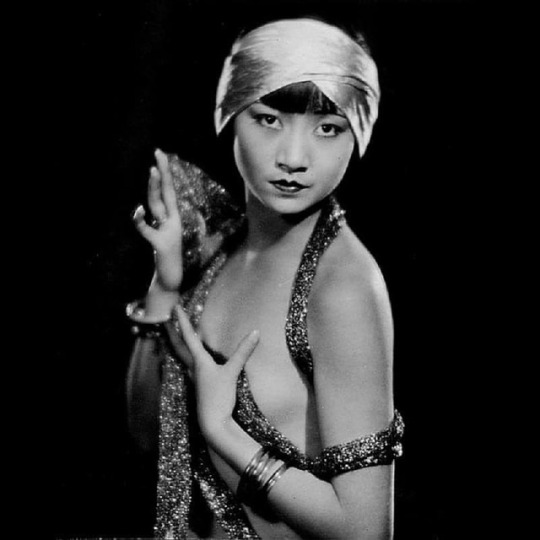
☆ “It’s a pretty sad situation to be rejected by [the] Chinese because I’m ‘too American’ and by American producers because they prefer other races to act Chinese parts.” –𝗔𝗻𝗻𝗮 𝗠𝗮𝘆 𝗪𝗼𝗻𝗴 (1905–1961), U.S. actress of Chinese descent | 📷 Edwin Bower Hesser (American, 1893–1962), circa 1924
Anna May Wong, the first Chinese American Hollywood film star and the first Chinese American actress to gain international fame, was dealt the most severe disappointment of her career in 1935, when film studio Metro-Goldwyn-Mayer refused to consider her for the leading role of the Chinese character O-Lan in the film 𝘛𝘩𝘦 𝘎𝘰𝘰𝘥 𝘌𝘢𝘳𝘵𝘩 (1937). The part went to white actress Luise Rainer, who played it in 'yellowface’ and won the 1937 Academy Award for Best Actress for that performance. (Text adapted from Wikipedia)
https://www.instagram.com/p/B13fROQIl_q/?igshid=a7233mv5w3xw
48 notes
·
View notes
Text

Janet Gaynor (born Laura Augusta Gainor; October 6, 1906 – September 14, 1984) was an American film, stage and television actress and painter.
Gaynor began her career as an extra in shorts and silent films. After signing with Fox Film Corporation (later 20th Century-Fox) in 1926, she rose to fame and became one of the biggest box office draws of the era. In 1929, she was the first winner of the Academy Award for Best Actress for her performances in three films: 7th Heaven (1927), Sunrise: A Song of Two Humans (1927), and Street Angel (1928). This was the only occasion on which an actress has won one Oscar for multiple film roles. Gaynor's career success continued into the sound film era, and she achieved a notable success in the original version of A Star Is Born (1937), for which she received a second Best Actress Academy Award nomination.
After retiring from acting in 1939, Gaynor married film costume designer Adrian with whom she had a son. She briefly returned to acting in films and television in the 1950s and later became an accomplished oil painter. In 1980, Gaynor made her Broadway debut in the stage adaptation of the 1971 film Harold and Maude and appeared in the touring theatrical production of On Golden Pond in February 1982. In September 1982, she sustained multiple injuries when the taxicab in which she and others were passengers was struck by a drunken driver. These injuries eventually caused her death in September 1984.
Gaynor was born Laura Augusta Gainor (some sources stated Gainer) in Germantown, Philadelphia. Nicknamed "Lolly" as a child, she was the younger of two daughters born to Laura (Buhl) and Frank De Witt Gainor. Frank Gainor worked as a theatrical painter and paperhanger. When Gaynor was a toddler, her father began teaching her how to sing, dance, and perform acrobatics. As a child in Philadelphia, she began acting in school plays. After her parents divorced in 1914, Gaynor, her sister, and her mother moved to Chicago. Shortly thereafter, her mother married electrician Harry C. Jones. The family later moved west to San Francisco.
After graduating from San Francisco Polytechnic High School in 1923, Gaynor spent the winter vacationing in Melbourne, Florida, where she did stage work. Upon returning to San Francisco, Gaynor, her mother, and stepfather moved to Los Angeles, where she could pursue an acting career. She was initially hesitant to do so, and enrolled at Hollywood Secretarial School. She supported herself by working in a shoe store and later as a theatre usher. Her mother and stepfather continued to encourage her to become an actress and she began making the rounds to the studios (accompanied by her stepfather) to find film work.
Gaynor won her first professional acting job on December 26, 1924, as an extra in a Hal Roach comedy short. This led to more extra work in feature films and shorts for Film Booking Offices of America and Universal. Universal eventually hired her as a stock player for $50 a week. Six weeks after being hired by Universal, an executive at Fox Film Corporation offered her a screen test for a supporting role in the film The Johnstown Flood (1926). Her performance in the film caught the attention of Fox executives, who signed her to a five-year contract and began to cast her in leading roles. Later that year, Gaynor was selected as one of the WAMPAS Baby Stars (along with Joan Crawford, Dolores del Río, Mary Astor, and others).
By 1927, Gaynor was one of Hollywood's leading ladies. Her image was that of a sweet, wholesome, and pure young woman who was notable for playing her roles with depth and sensitivity. Her performances in 7th Heaven, the first of 12 films she would make with actor Charles Farrell; Sunrise, directed by F. W. Murnau; and Street Angel, also with Charles Farrell, earned her the first Academy Award for Best Actress in 1929, when for the first and only time the award was granted for multiple roles, on the basis of total recent work rather than for one particular performance. This practice was prohibited three years later by a new Academy of Motion Picture Arts and Sciences rule. Gaynor was not only the first actress to win the award, but at 22, was also the youngest until 1986, when actress Marlee Matlin, 21, won for her role in Children of a Lesser God.
Gaynor was one of only a handful of established lead actresses who made a successful transition to sound films. In 1929, she was reteamed with Charles Farrell (the pair was known as "America's favorite love birds") for the musical film Sunny Side Up. During the early 1930s, Gaynor was one of Fox's most popular actresses and one of Hollywood's biggest box office draws. In 1931 and 1932, she and Marie Dressler were tied as the number-one box office draws. After Dressler's death in 1934, Gaynor held the top spot alone.[9] She was often cited as a successor to Mary Pickford, and was cast in remakes of two Pickford films, Daddy Long Legs (1931) and Tess of the Storm Country (1932). Gaynor drew the line at a proposed remake of Rebecca of Sunnybrook Farm, which she considered "too juvenile".
Gaynor continued to garner top billing for roles in State Fair (1933) with Will Rogers and The Farmer Takes a Wife (1935), which introduced Henry Fonda to the screen as Gaynor's leading man. However, when Darryl F. Zanuck merged his fledgling studio, Twentieth Century Pictures, with Fox Film Corporation to form 20th Century-Fox, her status became precarious and even tertiary to those of burgeoning actresses Loretta Young and Shirley Temple. According to press reports at the time, Gaynor held out on signing with the new 20th Century-Fox until her salary was raised from $1,000 a week to $3,000. The studio quickly issued a statement denying that Gaynor was holding out for more money. She quietly signed a new contract, the terms of which were never made public.
Gaynor received top billing above Constance Bennett, Loretta Young, and Tyrone Power in Ladies in Love (1937) but her box office appeal had already begun to wane: once ranked number one, she had dropped to number 24. She considered retiring due to her frustration with studio executives, who continued to cast her in the same type of role that brought her fame while audiences' tastes were changing. After 20th Century-Fox executives proposed that her contract be renegotiated and she be demoted to featured player status, Gaynor left the studio, but her retirement plans were quashed when David O. Selznick offered her the leading role in a new film to be produced by his company, Selznick International Pictures. Selznick, who was friendly with Gaynor off-screen, was convinced that audiences would enjoy seeing her portray a character closer to her true personality. He believed that she possessed the perfect combination of humor, charm, vulnerability, and innocence for the role of aspiring actress Esther Blodgett (later "Vicki Lester") in A Star Is Born. Gaynor accepted the role. The romantic drama was filmed in Technicolor and co-starred Fredric March. Released in 1937, it was an enormous hit and earned Gaynor her second Academy Award nomination for Best Actress; she lost to Luise Rainer for The Good Earth.
A Star Is Born revitalized Gaynor's career, and she was cast in the screwball comedy The Young in Heart (1938) with Paulette Goddard. That film was a modest hit, but by then Gaynor had definitely decided to retire. She later explained, "I had been working steadily for 17 long years, making movies was really all I knew of life. I just wanted to have time to know other things. Most of all I wanted to fall in love. I wanted to get married. I wanted a child. And I knew that in order to have these things one had to make time for them. So I simply stopped making movies. Then as if by a miracle, everything I really wanted happened." At the top of the industry, she retired at age 33.
In August 1939, Gaynor married Hollywood costume designer Adrian with whom she had a son in 1940. The couple divided their time between their 250-acre cattle ranch in Anápolis, Brazil, and their homes in New York and California. Both were also heavily involved in the fashion and arts community. Gaynor returned to acting in the early 1950s with appearances in live television anthology series including Medallion Theatre, Lux Video Theatre, and General Electric Theater.[8] In 1957, she appeared in her final film role as Dick Sargent's mother in the musical comedy Bernardine, starring Pat Boone and Terry Moore. In November 1959, she made her stage debut in the play The Midnight Sun, in New Haven, Connecticut. The play, which Gaynor later called "a disaster", was not well received and closed shortly after its debut.
Gaynor also became an accomplished oil painter of vegetable and flower still lifes. She sold over 200 paintings and had four showings under the Wally Findlay Galleries banner in New York, Chicago, and Palm Beach from 1975 to February 1982.
In 1980, Gaynor made her Broadway debut as "Maude" in the stage adaptation of the 1971 film Harold and Maude. She received good reviews for her performance, but the play was panned by critics and closed after 21 performances. Later that year, she reunited with her Servants' Entrance co-star Lew Ayres to film an episode of the anthology series The Love Boat. It was the first television appearance Gaynor had made since the 1950s and was her last screen role. In February 1982, she starred in the touring production of On Golden Pond. This was her final acting role.
Gaynor was romantically involved with her friend and frequent co-star, Charles Farrell, during the time of their work together in silent film, until she married her first husband. Choosing to keep their relationship out of the public eye, Gaynor and Farrell were often assisted by mutual friend Douglas Fairbanks Jr. in maintaining the ruse. Looking back, Fairbanks would later recall, "We three were so chummy that I became their 'beard,' the cover-up for their secret romance. I would drive them out to a little rundown, wooden house well south of Los Angeles, near the sea. I'd leave them there and go sailing or swimming until [it was] time to collect them and then we'd all have a bit of dinner."
According to Gaynor's biographer Sarah Baker, Farrell proposed marriage during the filming of Lucky Star, but the two never followed through with it. In her later years, Gaynor would hold their different personalities accountable for their eventual separation.
Gaynor was married three times and had one child. Her first marriage was to lawyer Jesse Lydell Peck, whom she married on September 11, 1929. Gaynor's attorney announced the couple's separation in late December 1932.
She was granted a divorce on April 7, 1933. On August 14, 1939, she married MGM costume designer Adrian in Yuma, Arizona. This relationship has been called a lavender marriage, since Adrian was openly gay within the film community while Gaynor was rumored to be gay or bisexual. The couple had one son, Robin Gaynor Adrian, born in 1940. Those rumors were never hinted at in newspapers or magazines. Gaynor and Adrian remained married until Adrian's death from a stroke on September 13, 1959.
On December 24, 1964, Gaynor married her longtime friend, stage producer Paul Gregory, to whom she remained married until her death. The two maintained a home in Desert Hot Springs, California and also owned 3,000 acres of land near Brasília.
Gaynor and her husband traveled frequently with her close friend Mary Martin and her husband. A Brazilian press report noted that Gaynor and Martin briefly lived with their respective husbands in Anapolis, state of Goiás at a ranch (fazenda in Portuguese) in the 1950s and 1960s – both houses are still there nowadays. There is a project by the Jan Magalinski Institute to restore their houses to create a Cinema Museum of Goiás.
On the evening of September 5, 1982, Gaynor, her husband Paul Gregory, actress Mary Martin, and Martin's manager Ben Washer were involved in a serious car accident in San Francisco. A van ran a red light at the corner of California and Franklin Streets and crashed into the Luxor taxicab in which the group was riding, knocking it into a tree. Ben Washer was killed, Mary Martin sustained two broken ribs and a broken pelvis, and Gaynor's husband suffered two broken legs. Gaynor sustained several serious injuries, including 11 broken ribs, a fractured collarbone, pelvic fractures, a punctured lung, and injuries to her bladder and kidney. The driver of the van, Robert Cato, was arrested on two counts of felony drunk driving, reckless driving, speeding, running a red light, and vehicular homicide. Cato pleaded not guilty and was later released on $10,000 bail. On March 15, 1983, he was found guilty of drunk driving and vehicular homicide and was sentenced to three years in prison.
As a result of her injuries, Gaynor was hospitalized for four months and underwent two surgeries to repair a perforated bladder and internal bleeding. She recovered sufficiently to return to her home in Desert Hot Springs, but continued to experience health issues due to the injuries and required frequent hospitalizations. Shortly before her death, she was hospitalized for pneumonia and other ailments. On September 14, 1984, Gaynor died at Desert Hospital in Palm Springs at the age of 77. Her doctor, Bart Apfelbaum, attributed her death to the 1982 car accident and stated that Gaynor "...never recovered" from her injuries.
Gaynor is buried at Hollywood Forever Cemetery next to her second husband, Adrian. Her headstone reads "Janet Gaynor Gregory", her legal name after her marriage to her third husband, producer and director Paul Gregory.
For her contribution to the motion picture industry, Janet Gaynor has a star on the Hollywood Walk of Fame at 6284 Hollywood Blvd.
On March 1, 1978, Howard W. Koch, then the president of the Academy of Motion Picture Arts and Sciences, presented Gaynor with a citation for her "truly immeasurable contribution to the art of motion pictures".
In 1979, Gaynor was awarded the Order of the Southern Cross for her cultural contributions to Brazil.
#janet gaynor#golden age of hollywood#classic hollywood#classic movie stars#old hollywood#classic cinema#classic movies#silent era#silent stars#silent cinema#silent hollywood#1920s hollywood#1930s hollywood
5 notes
·
View notes
Text
"CAMILLE" (1936) Review

"CAMILLE" (1936) Review
I am about to confess to something many might regard as sacrilegious. I have never regarded Greta Garbo as one of my favorite actresses from the Golden Age of Hollywood. I had nothing against her . . . personally. But I realized that I could barely recall any of her movies that were personal favorites of mine. Because of this, I was very reluctant to do a re-watch of one of Garbo's most famous films, "CAMILLE".
Produced by Irving Thalberg and directed by George Cukor, "CAMILLE" is based upon the 1848 novel and 1852 play "La Dame aux Camélias" ("The Lady with the Camellias") by Alexandre Dumas, fils. The movie told the story of Marguerite Gautier, a woman of low-class birth who rose to become one of Paris' top courtesans. Debt-ridden from helping friends and suffering from tuberculosis, Marguerite hopes to attract the attention of an aristocrat named Baron de Varville as her next "client" at the opera. However, just as she manages to attract the Baron's attention, Marguerite meets a young member of the bourgeois gentry named Armand Duval and instant attraction flares up between them. The attraction eventually develops into love. But external influences - including Marguerite's debts - threatens their potential for happiness.
I have not seen "CAMILLE" in a long time. A long time. There is a good chance I have not seen it since I was in my early twenties. But something . . . I have no idea what . . . led me to watch this film after so many years. In the end, the only regret that I managed to feel was that I had ignored this movie for so long.
Did I have any problems with "CAMILLE"? Perhaps a few. I noticed that the movie's narrative began in 1847 and ended roughly a year later. I think. Considering the story's setting, I found it surprising that the narrative never touched upon the political upheavals that swept throughout Europe between early 1848 and early 1849. In France, the upheaval was known as the French Revolution of 1848. During this event, the French king Louis Philippe I was overthrown in February 1848. Four months later, many Parisian workers had unsuccessfully risen in insurrection against the conservative Second Republic government. I realize that "CAMILLE" is not a political movie. But considering the film's setting and the fact that one character had plans for a diplomatic career (Armand Duval) and another was a wealthy aristocrat (Baron de Varville), I found odd that the topic of political upheaval was never touched upon.
I also had mixed feelings about the costumes created by legendary Hollywood designer, Adrian. I realize that the man had a reputation for creating some of Hollywood's most memorable and famous costumes. But . . . I do not know. Oh, yes I do. I think Adrian should have stuck to modern day costumes. His period costumes were not bad. Some of them have actually impressed me. A good example would be this particular costume from "CAMILLE" - namely Marguerite's dark velvet riding habit:
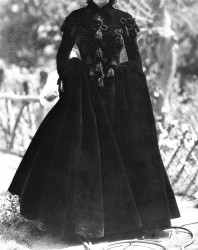
I also admired how Adrian managed to re-capture the fashion for men during the 1840s:

On the other hand, I had problems with some of the gowns worn by Greta Garbo, like the one shown in the image below:
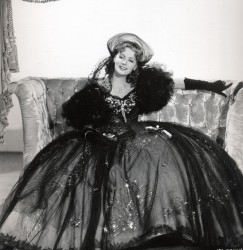
I was inclined to complain about the sequins featured in the costumes, but I discovered that they had been worn as part of fashion for thousands of years - including the 19th century. But I have other problems with the above costumes. One, they looked as if they came from some cheap costume warehouse. And two, Garbo looked as if she was about to be consumed by the voluminous amount of material used to create those gowns. Or could it be that Garbo lacked the figure for the fashions of the mid 19th-century? No . . . I do not believe that is a good excuse. I am certain that Western women of the 1840s came in different shapes and sizes as they do today. It is possible that Adrian had simply failed to design Garbo's costumes in a way that would fit her perfectly. As a high-priced courtesan, Marguerite Gautier had the funds to purchase a wardrobe filled with clothes tailored to fit her. I do not think that Adrian took the time to fit Garbo's costumes. Or perhaps she did not give him the time.
Otherwise, I cannot think of any other complaints about "CAMILLE". If I must be brutally honest, I think it is one of the best love stories I have ever seen in a motion picture, hands down. Ever. I was surprised that Alexandre Dumas fils, the son of the man who had written classics such as "The Three Musketeers" and "The Count of Monte Cristo", had written "La Dame aux Camélias" when he was roughly 23 years old. And screenwriters James Hilton, Zoë Akins and Frances Marion did a superb job in adapting Dumas' story.
"CAMILLE" could have easily developed into one of those sappy love stories in which only external forces stood in the lovers' way. And yes, Dumas' tale featured those "forces" that stood in the way of Marguerite and Armand's relationship - Baron Varville, Marguerite's bank account, her friends and Armand's father. But there were other forces in play. Namely, Marguerite and Armand. Between her passive aggressive personality, penchant for evading the truth and an inability to handle her finances; Marguerite had put herself into a situation that made it nearly impossible to have a genuine romance with Armand, let alone anyone. And poor Armand. I could say that he was completely faultless in this romance. But he was not. Armand was naive, hot-tempered, rash and a bit too stubborn and proud for his own good. Considering the state of her health, I do not believe Marguerite's romance with Armand was destined to last very long. However, I feel that it were not for their personal flaws, the pair could have enjoyed more time together than they actually had.
Many still regard Greta Garbo's performance as Marguerite Gautier as her finest performance. As I had hinted earlier in this review, I have only seen less than a handful of Garbo's movies. But I cannot deny that she gave a brilliant performance as the cynical, yet warm-hearted courtesan. Although Garbo was a healthy looking woman most of her life, I do admire how she utilized body language and facial expressions to convey Marguerite's questionable health and languid lifestyle. I have always suspected that Robert Taylor was one of the most underrated actors in Hollywood history. He had been in Hollywood for two years by the time he shot "CAMILLE". Many critics tend to focus on Garbo's performance when discussing the movie. As I had pointed out, she gave a superb performance. But so did Taylor, as Armand. He did an excellent job in conveying Armand's character from a very naive young man to someone who is a bit more cynical and mature. And yet, Taylor made sure to retain Armand's temper and stubbornness.
Another excellent performance came from Henry Daniell, who portrayed Marguerite's "client", Baron Varville. Daniell not only skillfully conveyed Varville's cool and arrogant nature, but also the character's slight infatuation with Marguerite and the pain he experienced in facing the reality of Marguerite's true feelings for him. Laura Hope Crewes, famous for her role in the 1939 Best Picture winner, "GONE WITH THE WIND", gave a very entertaining performance as one of Marguerite's closest friends, a veteran courtesan named Prudence Duvernoy. It is a shame that Crewes never earned an Oscar nomination for her performance. Her Prudence is a skillful mixture of friendly warmth and a mercenary nature. "CAMILLE" also featured first-rate performances from the likes of Lionel Barrymore, Rex O'Malley, Leonore Ulric, Jessie Ralph and Elizabeth Allan.
I was astounded to learn that "CAMILLE" had earned only one Academy Award nomination - Greta Garbo for Best Actress. And she lost to Luise Rainer's performance in "THE GREAT ZIEGFELD" . . . much to the surprise of the Hollywood community. Hell, I am not only shocked that "THE GREAT ZIEGFELD" had also won Best Picture, I am flabbergasted that "CAMILLE" did not even earn a Best Picture nomination, along with nominations for the leading actor, a screenplay nomination or a Best Direction nod for George Cukor. How did this travesty happen? A superb movie like "CAMILLE"?
The discovery of the limited amount of acclaim that "CAMILLE" had earned back in late 1936/1937 really convinced me how irrelevant that the Academy Awards truly are. Thankfully, movie fans still have the movie to enjoy for years to come, thanks to George Cukor's superb direction; a great screenplay by the likes of James Hilton, Zoë Akins and the legendary Frances Marion; and a superb cast led by the iconic Greta Garbo and the excellent Robert Taylor.
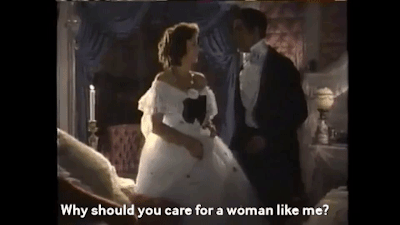
#la dame aux camélias#camille#camille 1936#alexandre dumas#george cukor#james hilton#zoe atkins#frances marion#irving thalberg#greta garbo#robert taylor#Henry Daniell#rex o'malley#laura hope crews#jessie ralph#lionel barrymore#elizabeth allan#leonore ulric#old hollywood#golden age of hollywood#period drama#costume drama#july monarchy
3 notes
·
View notes
Text
Racism in Hollywood
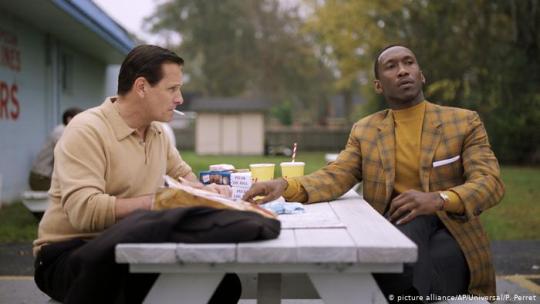
Image by DW
Racism was one of the worst trends in United States history. Hollywood industry in the past was the significant community that racism can be found. One of the explicit examples of racism in Hollywood occurred in 1973. The actor Marlon Brando refused the Academy Award for best actor from his performance ‘The Godfather’ for resisting the action of Hollywood film industry on native American. He sent Sacheen Littlefeather, then-president of the National Native American Affirmative Image Committee, as the representative of Marlon Brando for refusing Oscar with reasons. There were some audience boos at her (Robinson, 2014). It can be seen that racist tend to be normal in the 1970s. Even motion pictures did something that was partial to native American, people in that era still ignored it and felt that it is bad to call out for justice a group of people with colors. In addition, Asian actors were also face enormous racist they had seen. One explicit example is Anna May Wong, the first Asian American movie star, used to had the audition for ‘The Good Earth’, the movie that includes the life of a family in a Chinese farming village. She was failed to get the role as the producer disappointed on her look. The role was finally took by German-American Luise Rainer, who was dressed in yellowface. It earned her an Oscar in 1938 (Philippe, 2020). This flout to Anna May Wong who has the blood of Chinese, but never has a chance to get the role. The actress who got the role do not include Chinese blood, but she won Oscar from this role. This is considered to be one of the worst racists that exists in Hollywood history.
References
https://www.businessinsider.com/marlon-brando-rejected-godfather-oscar-2014-2
https://www.oprahmag.com/entertainment/tv-movies/a32345890/anna-may-wong-facts-real-story/
0 notes
Text
New Post has been published on Cinephiled
New Post has been published on http://www.cinephiled.com/seven-surprising-discoveries-2017-tcm-classic-film-festival/
Seven (Surprising) Discoveries at the 2017 TCM Classic Film Festival
My eyes are still recovering from watching back-to-back movies from 9 am to midnight for days on end at the eighth annual TCM Classic Film Festival last week in Hollywood. But, eye strain aside, it is an exciting, joyous event for the thousands of classic movie lovers who come to town from all over the world for the festivities. I can’t even tell you how much I look forward to this four-day festival. Taking place in two historic 1920s movie palaces, Sid Grauman’s stunning Chinese and Egyptian theaters on Hollywood Boulevard, as well as the neighboring TCL Chinese Multiplex and a few presentations at the nearby Cinerama Dome, there are up to five concurrent presentations taking place in every time slot (totaling more than 100 films) over the course of the festival. Choosing what to see when there are so many great options is part of the agonizing fun.
I’ve attended every TCM Festival since it began in 2010 and this year’s was especially poignant following the death last month of the beloved TCM host and father figure Robert Osborne at the age of 84. Getting a chance to meet Osborne at the festival and hear him introduce films and interview the actors and filmmakers he knew so well was every bit as exciting as meeting our favorite stars. This year, the entire festival was dedicated to Robert Osborne and there were many tears at various remembrances. Also many laughs, as this year’s overall theme was comedy in the movies. Sadly, many of the people who attended the festival in years past are no longer with us. I have so many wonderful memories of hearing stars such as Debbie Reynolds, Tony Curtis, Maureen O’Hara, Luise Rainer, Mickey Rooney, Betty Garrett, Esther Williams, and so many others talk to us about their work. This year’s special guests included incredibly talented folks such as Carl and Rob Reiner (who became the first father and son to get their footprints immortalized in cement in the famous Grauman’s Chinese forecourt), Sidney Poitier, Genevieve Bujold, Michael Douglas, Peter Bognonavich, Lee Grant, Buck Henry, Keir Dullea, Richard Dreyfuss, Dick Cavett, Ruta Lee, and Mel Brooks. Taking up hosting duties in Robert Osborne’s absence were movie experts and TCM family members Ben Mankiewicz, Illeana Douglas, Cari Beauchamp, and Leonard Maltin, among others.
In addition to seeing great movies the way that should be seen and meeting some of the people who made them, one of the best parts of the festival is getting a chance to hang out with fellow movie lovers of all ages and from all walks of life. I have made many friendships at the festival which continue online throughout the year as we share notes and gab about our hopes for the next year’s offerings. The night before the festival, the online TCM group I am a part of gets together at the historic Hollywood Roosevelt Hotel (site of the very first Academy Awards and the festival headquarters) and we often bring in a special guest. This year I interviewed the glamorous and talented Barbara Rush who regaled us for over an hour with stories of her amazing films and co-stars including Frank Sinatra, Rock Hudson, Paul Newman, Marlon Brando, James Mason, Montgomery Clift, Richard Burton, Kirk Douglas, and many others. Barbara, who turned 90 in January, was so full of energy she was still going strong hours later across the street at Musso & Frank’s, holding court with an adoring crowd over dinner and sharing poignant stories of her close longtime friendship with Robert Osborne. I also got the chance to spend some time at our gathering with Cora Sue Collins, renowned child star of the 1930s who was handpicked by Greta Garbo to play Garbo as a child in Queen Christina (1933) and also appeared with the great Swedish star in Anna Karenina (1935). As a young girl, Cora Sue acted in many other well-known films such as Treasure Island (1934) with Wallace Beery and Jackie Cooper and Evelyn Prentice (1934) in which she played the daughter of Myrna Loy and William Powell. She so enjoyed visiting with us two years ago that she came back to see us this year and had a mini-reunion with Barbara Rush (Cora Sue had appeared in the 1935 version of Magnificent Obsession with Irene Dunne and Robert Taylor while Barbara was in the 1954 Douglas Sirk version of the story with Jane Wyman and Rock Hudson).
Sitting in movies from early morning until midnight for several days in a row is a thrilling treat that requires stamina and an understanding family, but I wish I could do it all over again just to see some of the films I missed at this year’s festival. Films such as Jezebel (1938), Born Yesterday (1950), The Bridge on the River Kwai (1967), Broadcast News (1987), Laura (1944), Twentieth Century (1934), The China Syndrome (1979), The Last Picture Show (1971), David and Lisa (1962), The Great Dictator (1940), Bye Bye Birdie (1963), Theodora Goes Wild (1936), King of Hearts (1966), Bonnie and Clyde (1967), Postcards from the Edge (1990), Casablanca (1942), and so many others. Oh, the pain! And yet I don’t regret ANY of my choices, from the films I’ve seen dozens of time to the new discoveries. Despite being a classic movie fanatic, there are some surprising holes in my movie repertoire — I can’t tell you how many times I heard my TCM friends exclaim, “You’ve NEVER seen The Awful Truth or The Palm Beach Story? What the hell is wrong with you?!” I can’t explain why I’ve missed some of the classics, especially when I’ve seen so many other films such as The Philadelphia Story, Meet Me in St. Louis, and All About Eve at least 50 times each. Here’s a rundown of seven films I saw at the festival this year for very first time (in alphabetical order so I don’t play favorites):
1. The Awful Truth (Columbia, 1937). Such utter joy with Cary Grant, Irene Dunne, and Ralph Bellamy at their screwball best. Leo McCarey won his first of three Oscars for this film (although he personally felt that he deserved it more for his drama that came out earlier that year, Make Way for Tomorrow, that screened at the 2014 festival). I have no idea how I missed The Awful Truth all these years but seeing it with a big audience on a huge screen was a great introduction and we all laughed ourselves silly at the story of Jerry and Lucy Warriner — a loving couple that splits up early in the film and then keep sabotaging each other’s relationships before their final divorce kicks in. Grant was reportedly very unhappy with McCarey’s directing style during this film, which included a fair amount of improvisation (rare for the 1930s), and tried to get off the film. Thank goodness he didn’t succeed since his performance set the stage for many of his best comedies to come including three more films (The Philadelphia Story, His Girl Friday, and My Favorite Wife) that featured divorced couples who rediscover each other and fall back in love. The best screwball comedies always include a bunch of perfectly played smaller roles and here I’d like to call out Egyptian actor Alexander D’Arcy as Irene Dunne’s questionable companion, Armand Duvalle, and Joyce Compton as Cary Grant’s showgirl squeeze, Dixie Belle Lee. My favorite part of The Awful Truth may be when Irene Dunne crashes a party at the home of Grant’s new fiancée, heiress Barbara Vance, and poses as his gum-chewing sister, performing one of Dixie Lee’s risqué nightclub numbers we saw earlier. The film also features Nick and Nora Charles’ dog Asta in the key role of the Warriners’ pooch, Mr. Smith. Grant and Dunne would go on to co-star in two more great movies, My Favorite Wife (1940), and Penny Serenade (1941).
2. The Court Jester (Paramount, 1955). Danny Kaye seems to be an acquired taste, I’ve spoken to many classic movie fans who are lukewarm on Kaye and his films. As a young kid I loved Kaye’s TV variety show, and I remember enjoying him in perennial broadcasts of White Christmas and Hans Christian Anderson. But I approached this film with a fair amount of trepidation myself, I really didn’t know what to expect, and have to admit I was flabbergasted by how much I loved it. Seeing a glorious Technicolor restoration on the huge Grauman’s Chinese screen didn’t hurt, nor did the fascinating discussion of the film and Danny Kaye’s work between Illeana Douglas and actor Fred Willard (a huge Danny Kaye fan) before the screening. Kaye is just brilliant in the triple role (sorta) of Hubert Hawkins and his masquerade as Giacomo the Jester in order to gain entry into the royal palace so that he and his friends can reinstall the rightful heir to the throne, a baby with a telling birthmark on his butt, the “purple pimpernel.” Confused? Don’t worry, it’ll all make sense when you watch the crazy fun, including Kaye’s “third” role as a much more menacing Giacomo after he’s hypnotized by Griselda (Mildred Natwick). With beautiful Glynis Johns as Kaye’s fellow rebel and eventual love interest, Maid Jean, and a young and gorgeous Angela Lansbury as the recalcitrant Princess Gwendolyn who falls in love with the hypnotized Kaye, the film provides lots of color, music, and howls from beginning to end, especially with great actors such as Basil Rathbone, Cecil Parker, and John Carradine playing it completely straight during the nonsense. Danny Kaye’s particular style of wordplay is at its peak here: “The pellet with the poison’s in the vessel with the pestle; the chalice from the palace has the brew that is true!”
3. Lady in the Dark (Paramount, 1944). Introduced by actress Rose McGowan, the final film I saw at the festival on Sunday night was a rare screening of the nitrate Technicolor print of Mitchell Leisen’s Lady in the Dark starring Ginger Rogers, Ray Milland, Warner Baxter, and Jon Hall. To say that this is one CRAZY-ASS film is an understatement. Loosely based on the successful Moss Hart-directed Broadway musical of the same name with songs by Ira Gershwin and Kurt Weill, the film stars Ginger Rogers as the no-nonsense editor-in-chief of Allure, a successful fashion magazine. The repressed Ginger is dating her older publisher (Baxter) despite the fact that his wife won’t give him a divorce and she is constantly battling with one of her top editors (Milland) in such an irritated way that you KNOW they will ultimately end up together. But poor overworked Ginger is plagued by strange nightmares (which we see in all their bizarre Technicolor glory) and is finally persuaded to visit a shrink (Barry Sullivan) who convinces her that something traumatic from her past is responsible for her decision to eschew all glamour and femininity (a ridiculous assertion given Ginger’s beauty and her allegedly “plain” clothes that any woman I know would kill for). Enter visiting hunky movie star Randy Curtis (Hall) who everyone in the magazine’s office (except for Ginger, of course) goes GAGA for, including the openly gay photographer (Mischa Auer in the part that made Danny Kaye a star on Broadway) and the male assistants at the magazine (I guess in 1944 it was okay to show male-to-male attraction in the context of employees at a fashion magazine). But Curtis only has eyes for Ginger, and her dreams take an even odder turn. The costumes in this film (by Edith Head, Raoul Pene du Bois, and Barbara Karinska) are miles over-the-top, including a bejeweled mink-lined number (now in the Smithsonian) that was so heavy Ginger needed a second, lighter version of it made for the dance sequence. What this movie says about psychotherapy, femininity, and relationships is so outrageous and politically incorrect that one friend of mine at the screening immediately pronounced the film “monstrous.” But it is fascinating time capsule of another time and place, and definitely worth seeing even though it’s so weird I now feel like I may need a visit with Rogers’ psychiatrist.
4. Love Crazy (MGM, 1941). This was the first film I saw at this year’s festival, introduced by the wonderful actress Dana Delany who is a classic movie lover and has appeared with Robert Osborne on TCM. And what’s a comedy-themed film festival without William Powell and Myrna Loy? This was the tenth of fourteen films the two made together (including the six Thin Man films) and one of the few I’d never seen. In true screwball style, Powell and Loy play the married Steve and Susan Ireland, a deliriously happy couple celebrating their fourth wedding anniversary until Susan’s overbearing mother (Florence Bates) arrives to mess up everything. Next thing we know, Powell runs into his old girlfriend (the beautiful and snide Gail Patrick, a favorite of mine in Stage Door and My Man Godfrey) who has just moved into their swanky apartment building. Alas, a series of zany misunderstandings involving Patrick, her husband, and a random neighbor who is a world champion archer (Jack Carson) lead to Powell and Loy’s impending divorce. After a few additional escapades, the hapless Steve ends up being committed to a sanitarium by the City Lunacy Commission who mistakenly believe he is a homicidal maniac. We even get to see Powell in drag when, hiding from the police, he disguises himself as his own sister (which forced the actor to temporarily shave off his signature mustache). I know I don’t need to tell you that Powell and Loy eventually come to their senses and continue on in wedded bliss. The film, directed by underrated MGM director Jack Conway, includes some funny inside jokes such as a drunken William Powell singing “It’s Delightful to Be Married” at the beginning of the film, a song sung by his on-screen wife Luise Rainer several years earlier in The Great Ziegfeld.
5. The Palm Beach Story (Paramount, 1942). Of all of my discoveries at this year’s festival, it’s especially hard to believe that I had never seen this film, given my love of Preston Sturges and every single member of the glittering cast. I’m happy to say that the movie surpassed my high expectations and immediately leapfrogged to my list of all-time favorites. Preceded by a discussion between film scholar Cari Beauchamp and Wyatt McCrea, star Joel McCrea’s oldest grandchild, we were also introduced to several of Mary Astor’s great-grandchildren who were present at the screening, including Andrew Yang who wrote the foreword to the fascinating book I just finished reading, The Purple Diaries: Mary Astor and the Most Sensational Hollywood Scandal of the 1930s by Joseph Egan. In the brilliant comedy, McCrea and Claudette Colbert play Tom and Gerry Jeffers, a married couple in New York that is down on their luck financially — way down. I don’t even want to explain the rest of the plot because if you’ve never seen the film it will be fun to come to it fresh as I did, but let’s just call out a few of the crazy folks that McCrea and Colbert come into contact with during their adventures, from the Wienie King (Robert Dudley) to clueless zillionaire John D. Hackensacker III (Rudy Vallee) who wants to shower Colbert with riches, to Hackensacker’s eccentric sister, The Princess Centimillia (Mary Astor) who wants to do the same to McCrea. Carole Lombard was originally slated for this film before her tragic death in a plane crash that year, but Colbert does a brilliant job in the role. Astor was apparently insecure about her comedy chops and terrified that she wasn’t giving Sturges what he wanted, but as far as I’m concerned, she’s one of the best things in the film. The Palm Beach Story is a delightful antidote to Palm Beach’s current place in our consciousness as the home of Mar-a-Lago.
6. Rafter Romance (RKO, 1933). It’s always great fun to see pre-code films at the festival, those films that were made in the early 1930s before the Motion Picture Production Code put an end to many of the risqué plot lines that were once commonplace in the movies. The rarely seen Rafter Romance starring a young Ginger Rogers (just before she was first teamed with Fred Astaire in Flying Down to Rio) was a wonderful example of all that pre-codes have to offer. Caught up in a copyright battle for decades, our host Leonard Maltin explained that this was one of the first public screenings of the film since its release in 1933. Ginger plays a young woman who moves to New York to find a job but is having a terrible time making ends meet. Her landlord, Max Eckbaum (George Sidney, a Jewish immigrant from Hungary who was the uncle of the younger George Sidney, a director of many musicals including another of this year’s festival offerings, Bye Bye Birdie), suggests a solution. Ginger can share an apartment with another tenant in his building, a man she doesn’t know who is an artist but works as a night watchman so they will never be around at the same time. But that doesn’t keep the two from endlessly fighting via sharply worded notes left around the apartment. Of course confusion and hijinks ensue when the two meet, unaware that they are each other’s hated co-tenant. Added to the mix are Robert Benchley as Ginger’s lecherous boss and Laura Hope Crews (years before she appeared in Gone With the Wind as Scarlett’s Aunt Pittypat) as Foster’s sex-starved art patron. One interesting thing that Maltin pointed out to us was how, in addition to changes in language and depictions of sex, the dreaded Production Code also curtailed the existence of ethnic characters in mainstream movies to a large extent, such as the character of Ginger’s Jewish landlord and his Yiddish-speaking wife (played by Ferike Boros who nevertheless appeared in small parts in several subsequent Ginger Rogers films including Bachelor Mother, Fifth Avenue Girl, and Once Upon a Honeymoon).
7. Red-Headed Woman (MGM, 1932). Historian and author Cari Beauchamp introduced us to another delicious pre-code that I’d never seen, the fabulous Jean Harlow vehicle, Red-Headed Woman, directed by Love Crazy’s Jack Conway. This one is so out there and provocative it makes Rafter Romance look like Rebecca of Sunnybrook Farm. With a sizzling screenplay by Anita Loos (Gentleman Prefer Blondes), Jean Harlow plays “Lil” Andrews, a woman who will do anything to get ahead — and I mean anything. She seduces her married boss (Chester Morris), causing him to divorce his devoted wife (Leila Hymans) who he really loves only to eventually throw him over for one of her new husband’s even richer clients (Henry Stephenson). The beloved character actress Una Merkel (whose opening credit elicited as much applause as Harlow’s in our classic movie-obsessed crowd) stands by Jean throughout the film, even during Lil’s dangerous affair with her poor but sexy French chauffeur (a young and almost unrecognizable Charles Boyer). Only someone with the incredible warmth, charm, beauty, and screen presence of 21-year-old Jean Harlow could make us root for a character that, when you think about it, is completely devoid of any human decency. Once the Production Code took full effect, someone who caused such destruction to so many lives would never be allowed to get away with it. But in 1932, she does, and I found myself cheering the surprising happy ending for the unrepentant but hugely charismatic Harlow. So tragic that the actress would die just five years later at the age of 26. Considering she’s been gone for a whopping 80 years, her impact on audiences, even today, is pretty remarkable.
Lots more great films this year, I could go on indefinitely. Is it too soon to start obsessing about next year’s festival? Being the total movie geek that I am, one of my proudest moments this year was realizing the close family connection between actors in two wildly different films that were made decades apart. Remember the Jewish landlords in 1933’s Rafter Romance? Their son, Julius Eckbaum, was played by young actor Sidney Miller. Sidney is the father of actor Barry Miller who I saw as Bobby C. in the screening of 1977’s Saturday Night Fever (with director John Badham and actress Donna Pescow in attendance). Can you believe the close resemblance between father and son? See you next year at the movies!
#Barbara Rush#Cora Sue Collins#Lady in the Dark#Love Crazy#Rafter Romance#Red-Headed Woman#Robert Osborne#TCM Classic Film Festival#The Awful Truth#The Court Jester#The Palm Beach Story#Features#What's Hot
0 notes
Text
“It’s still hard:” Asian Americans Paving the Way in Hollywood By Jessica Pickens

The 2018 film CRAZY RICH ASIANS was a success in many areas. Based on the best-selling novel by Kevin Kwan, the film became the highest-grossing romantic comedy in 10 years. An August 2018 article in Time Magazine noted that the film would “change Hollywood.” CRAZY RICH ASIANS was the first film since THE JOY LUCK CLUB (’93) to have an all-Asian American cast or an Asian American lead role. Nearly 60 years before, the all Asian American cast of FLOWER DRUM SONG (‘61) also hoped they were changing the way Asians were cast in Hollywood.
Since the silent era of films, Asian American actors have struggled to find quality roles and respect in Hollywood. Some, actors like Sessue Hayakawa and Anna May Wong, were frequently cast as vamps or villains — which in return put them in poor favor with Japanese and Chinese communities of their time. Miscegenation laws kept Asian American actors from having a romantic leading role with a white actor. In turn, Asians lost roles to white actors in yellowface, from Austrian actress Luise Rainer in THE GOOD EARTH (’37) to English actor Alec Guinness in A MAJORITY OF ONE (’61).
These actors helped fight and pave the way for the success of CRAZY RICH ASIANS:
Sessue Hayakawa

Today, actor Sessue Hayakawa is best recognized for his roles in THE BRIDGE ON THE RIVER KWAI (’57) and as the pirate in Walt Disney’s SWISS FAMILY ROBINSON (’60). But from 1915 to the early 1920s, Japan-born Hayakawa was one of the top silver screen idols of the silent era in the United States and Europe. He was as famous and recognizable as Charlie Chaplin or Douglas Fairbanks, according to his biographer Daisuke Miyao in the book Sessue Hayakawa: Silent Cinema and Transnational Stardom.
Fame followed Hayakawa after playing the lead in Cecil B. DeMille’s THE CHEAT (’15), in which he gives a financial loan to a wealthy woman (Fannie Ward). When she tries to back out of their bargain, he won’t take money as payment, but sexual favors. His character also brands Ward to signify that he owns her. THE CHEAT brought Hayakawa success, but it also brought typecasting. His resulting characters were usually dangerous, forbidden lovers or sexy villains. Hayakawa was criticized by the Japanese-American community for his roles. The Los Angeles-based Japanese American newspaper Rafu Shimpo said THE CHEAT “distorted the truth of Japanese people” depicting them as dangerously evil and would cause anti-Japanese movements.
Hayakawa eventually grew tired of the stereotypical roles he was cast in. In 1922, Hayakawa went to Europe where he performed in England and France. He stayed in Europe until after World War II and returned to Hollywood in 1949. Hayakawa was recognized for his role in THE BRIDGE ON THE RIVER KWAI with an Academy Award nomination for Best Actor in a Supporting Role.
Anna May Wong

She was rejected by China because she was “too American” and rejected in Hollywood because she was “too Chinese.” But Chinese American actress Anna May Wong achieved international fame by the mid-1920s, though she struggled with being stereotyped. Often cast as a vamp, sexual figure, slave or prostitute, the Chinese government said she played roles that demeaned China, and Graham Russell Hodges’ Anna May Wong: From Laundryman's Daughter to Hollywood Legend recalls how the Chinese media and government resented “having their womanhood so represented.”
When Wong campaigned for roles that could potentially change her image, like O-Lan in THE GOOD EARTH, she lost out to a white actor playing yellowface. In fact, the Chinese government worked against Wong being cast in THE GOOD EARTH. Hodges states how General Tu, MGM’s Chinese government advisor, told MGM that her reputation was bad in China and whenever she appeared in a film, newspapers printed that “Anna May loses face in China again.”
When white actor Paul Muni was cast as the male lead of THE GOOD EARTH, Wong knew she had missed her opportunity because of miscegenation laws. Wong supported China during World War II through the Red Cross, USO and China Relief efforts. She also wrote articles in China’s support and created a cookbook of traditional Chinese dishes. On the first anniversary of the Pearl Harbor attacks, she was sworn in as an air raid warden, according to Hodge’s book.
In 1943, the First Lady of the Republic of China, Madame Chiang Kai-shek, visited Hollywood. She gave a speech at the Hollywood Bowl and a luncheon was held. Madame Chiang Kai-shek was flanked by actresses like Marlene Dietrich and Loretta Young, but noticeably not Wong. Madame Chiang had specifically requested for Wong to be excluded from the events. Anna May Wong continued to act sporadically and died just before she was to co-star in the all Asian American cast of THE FLOWER DRUM SONG.
Keye Luke
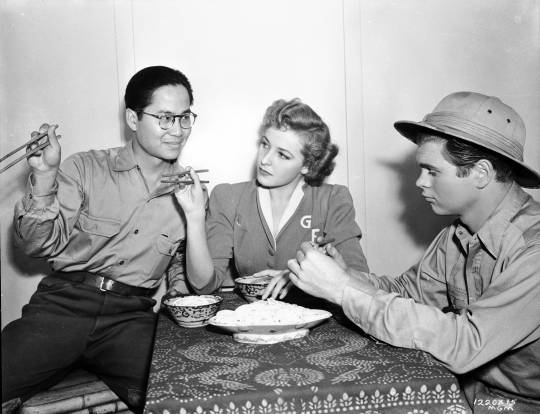
Chinese actor Keye Luke started in films in the 1930s, usually playing a mild-mannered, polite and intelligent young adult Asian male. Often, Luke played young physicians, like in THE PAINTED VEIL (’34), MAD LOVE (’35) and the Dr. Kildare and Dr. Gillespie film series. Luke became best known for his role in the 1930s as Lee Chan, the No. 1 son of detective Charlie Chan, who was played by white actor Warner Oland. The film series has since been criticized for perpetuating Asian stereotypes and having a white actor in the lead role, but Luke defended the films.
“How can they be criticized when the character was a hero,” Luke said in a 1986 Los Angeles Times interview. “People respected him. Police departments consulted with him and called on him to help them.” However, despite this, Luke and other Asians faced racism in Hollywood. Luke said in the 1930s that Los Angeles was “segregated, but not formally.” He was only hired when they needed a “Chinaman.”
“One never saw blacks on Wilshire Boulevard. Parts of the city I avoided–all white areas like Beverly Hills. Even after working with somebody like a big Caucasian actor, I’d be ignored if we met on the street. Asians were invisible, you see. We knew our place: One step back. That’s why the Charlie Chan films were so important. They deflated a lot of the current racial myths. But even the Chan films had rules. Charlie never touched a white woman except as a handshake. I’d never have a white girlfriend, not that I wanted one in pictures,” Luke said in an interview published in Conversations with Classic Film Stars: Interviews from Hollywood's Golden Era by James Bawden and Ron Miller.
After World War II, Luke found roles were harder to find, and many of his roles were uncredited. By the 1960s, more Asian actors were on the screen. In his interview with Miller, Luke joked that before the 1960s he and Korean actor Philip Ahn “divided the work.”
Philip Ahn

Philip Ahn was a Korean American actor who only played a Korean character once on film. In Hye Seung Chung’s Hollywood Asian: Philip Ahn and the Politics of Cross-Ethnic Performance, he details how before World War II, Ahn was promoted as a Chinese actor and often nicknamed the “Oriental Clark Gable.” During World War II, however, Hollywood shifted its publicity and focused on Ahn’s Korean ancestry. The publicity articles discussed Ahn’s father, Ahn Changho, who was an activist against the Japanese government. Ahn was also promoted as “the man we love to hate” and the “leering yellow monster.”
During the war, Ahn was frequently cast as a Japanese soldier in the 1940s, something he later said that he didn’t mind, as he felt he was contributing to his late father's legacy. Despite these characters not reflecting Ahn’s personality, Chung recalls how Ahn received hate mail from audiences who confused his onscreen characters for real life. In the 1953 Korean War film BATTLE CIRCUS, Ahn and his brother Ralph both played North Korean prisoners. Ahn said while he played many nationalities, this was the only time he played a Korean character, according to his 1978 The New York Times obituary.
Miyoshi Umeki

Japan-born Miyoshi Umeki was the first Asian to win an Academy Award for a performance. Umeki won Best Supporting Actress for her first Hollywood film, SAYONARA (’57). Though Umeki was the first Asian to win an Academy Award, this “first” isn’t often discussed. Despite the accolade, Umeki was still stereotyped in Hollywood. Her characters were generally demure, humble, delicate and subservient. Umeki’s characters spoke in broken English with a sweet smile.
Her son Michael Hood later asked her why she agreed to play these characters. “Her answer was very simple: ‘I didn’t like doing it, but when someone pays you to do a job, you do the job, and you do your best,’” Hood said in a 2018 Entertainment Weekly article. Umeki later threw away her Academy Award statue, according to Hood. As of 2020, Umeki is the only Asian female to win an Academy Award.
Nancy Kwan
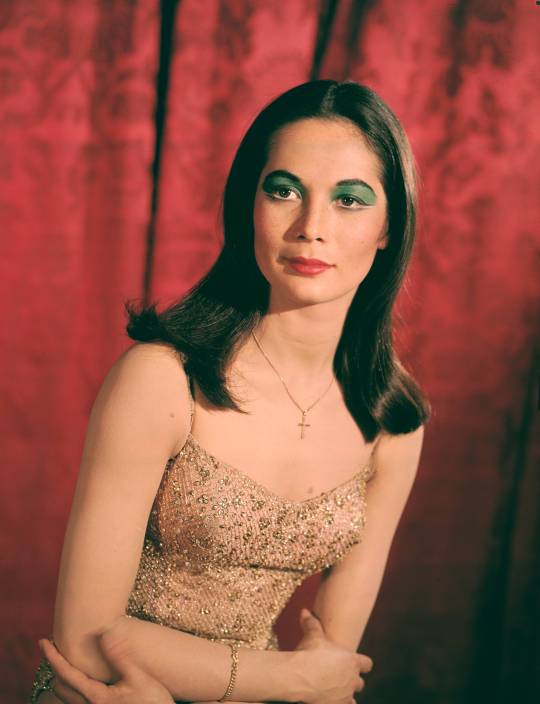
Hong Kong-born actress Nancy Kwan burst on to the film scene in 1960. She was cast as the lead in THE WORLD OF SUZIE WONG (’60) alongside one of Hollywood’s top actors, William Holden. Kwan was then cast in the all -Asian American cast of the Rodgers and Hammerstein film version of FLOWER DRUM SONG. With a strong start in films, a successful Hollywood career seemed likely for Kwan, but the roles weren’t there.
William Holden told her, “You can do a big film and be very successful but in order to sustain a career, you have to have roles written for you,” Kwan shared in a 2018 NBC interview. Kwan was more successful than her predecessors, however, as Asians were starting to be cast rather than white actors in yellowface. Kwan was also cast in roles where she had white romantic leading men, like HONEYMOON HOTEL (’64) and THE WILD AFFAIR (’65).
But Hollywood still didn’t know what to do with Kwan. She was cast in “exotic” roles like in the Walt Disney film LT. ROBIN CRUSOE, U.S.N. (’66) as an island girl. Kwan was offered a role in the film THE JOY LUCK CLUB, but she revealed in a 2018 interview at the TCM Classic Film Festival that she declined it because of a line criticizing SUZIE WONG. While she mentioned in a 1990 Los Angeles Times interview that “There are now many, many Asian actresses — but not many roles,” 18 years later she noted that the film industry had changed, but not enough. “There are more leading roles and not just small roles, but it’s still hard.”
#Asian American#Asians in Hollywood#Sessue Hayakawa#Anna May Wong#Philip Ahn#Miyoshi Umek#Keye Luke#Nancy Kwan#TCM#Turner Classic Movies#Jessica Pickens#classic hollywood
715 notes
·
View notes
Text
In Conversation with Eva Marie Saint and Norman Lloyd by Susan King
Anybody who has attended the TCM CLASSIC FILM FESTIVAL in Hollywood knows what a magical experience the event is for fans of vintage movies. There’s such good will, love and friendship there that it’s hard to choose what the favorite event is at the Festival, which would have celebrated its 11th edition this April until Covid-19 cancelled the four days of classic films.

One of the most popular presentations are the “Live From” events, which features some of the greatest actors and filmmakers from the Golden Age of Hollywood in conversation with the late, great TCM host Robert Osborne and now with Ben Mankiewicz, the channel’s primary host. These interviews have played on TCM over the years. And a select few, including interviews with Oscar-winners Luise Rainer, Eva Marie Saint, Faye Dunaway and such legends as Norman Lloyd and Peter O’Toole, will be featured during the TCM Classic Film Festival: Special Home Edition.
As a movie writer for 26 years at the L.A. Times. I’ve had the good fortune of interviewing many of these legends. Here are some memories of my conversations with two of my favorites, Eva Marie Saint and Norman Lloyd.
Eva Marie Saint
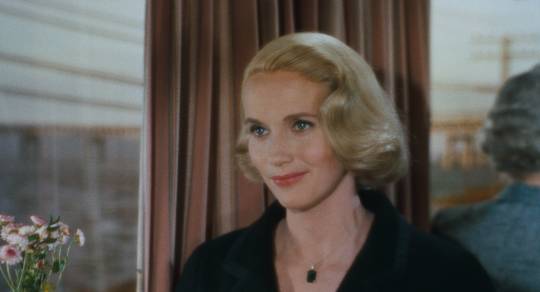
I have lost count of how many times I have interviewed Eva Marie Saint, now 95, who won a Best Supporting Actress Oscar as Edie, the girlfriend of Terry Malloy (Marlon Brando), in Elia Kazan’s 1954 Academy Award-winning masterpiece ON THE WATERFRONT.
But I remember the first time.
I was at the now defunct Los Angeles Herald Examiner when I was assigned to talk to her in 1986 about director Garry Marshall’s NOTHING IN COMMON, which stars Tom Hanks and Jackie Gleason in his final film. Saint had long been a favorite of mine. I was a huge fan of ON THE WATERFRONT and admired her performances in 1957’s RAINTREE COUNTY opposite Montgomery Clift and Elizabeth Taylor, Alfred Hitchcock’s 1959 romantic thriller NORTH BY NORTHWEST opposite Cary Grant and Otto Preminger’s 1960 epic EXODUS, where Saint was romanced by Paul Newman. I had also seen her on stage in 1979 in Los Angeles opposite Henry Fonda in the hit comedy First Monday in October.
From the moment she opened the door of the Westwood townhome she shared with her late director husband Jeffrey Hayden, I felt an immediate bond with her. Not only did we both hail from the same hometown, East Orange, N.J., Saint was down-to-earth, friendly and smart as a whip. And she’s always been frank and funny.
The last time I interviewed her in person in 2014, Saint talked about doing live TV in the late 1940s and 1950s. “My God, terrible things happened,” she said with a laugh, including exposing more than her talent on the soap opera One Man’s Family. Saint was doing a scene in a small pool opposite the actor who was playing her brother. At one point, she recalled, “someone was doing something offstage. You learn not to look away from what you are doing because you can be distracted.” But she finally looked, only to see a man off camera pulling his shirt up and down. “I looked down and saw my boobies were showing coast to coast,” Saint said, laughing. “I just kept in the scene and slid under the water. What could I do? It was live television. To this day, all of these years later, someone will say to me ‘Miss Saint, you were doing One Man’s Family…’ and I’ll say, ‘I remember.’”
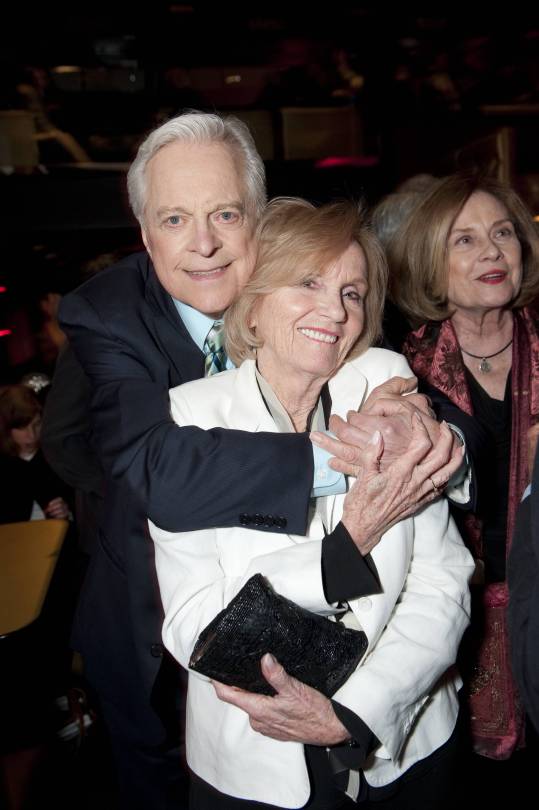
Saint was married to Hayden for 65 years until his death at 90 in late 2016. And he was as exceptional a person as Saint, sweet and friendly. I asked her how the two met. Saint was a young actress and model in New York in the late 1940s, and Hayden was working in radio at NBC. “He saw me on the subway from the back, and he liked the way I walked,” Saint said with a smile. Hayden also noticed a big black book she was carrying that was her modeling portfolio. “The book I was carrying said ‘Eva Marie Saint’ in gold letters,” she noted. “He thought ‘I like the name.’”
They were fated to meet. Not long after seeing her on the subway, Hayden saw her again at Radio City talking with actor Arnold Stang, who also happened to be the only actor that Hayden knew. “So, he could go over to Arnold and Arnold would say ‘Hi Jeff, do you know Eva Marie?’”
The married in 1951, had two children and grandchildren.
My heart skipped a beat when she talked about how strong their marriage was after six decades. Saint noted she had been “thinking about life and I guess I was a little low. I said ‘Jeffrey, what in today’s world inspires you?’ He put his head up and said ‘You.’”
Norman Lloyd

Norman Lloyd, who is still going strong at 105, is one of the most accomplished actors/producers/directors. Beginning as child actor in the 1920s, he starred on Broadway as a member of Orson Welles’ legendary Mercury Theatre in the late 1930s.
He’s appeared in countless movies, including as the evil villain who falls from the Statue of Liberty in Alfred Hitchcock’s 1942 classic thriller SABOTEUR, as well as Jean Renoir’s 1945 THE SOUTHERNER and Charlie Chaplin’s 1952 LIMELIGHT. And TV audiences may know him as the kindly Dr. Auschlander on NBC’s acclaimed medical drama St. Elsewhere from 1982-88.
Lloyd also had one of the strongest marriages in Hollywood. He and his wife Peggy, who died in 2011, were married for 75 years. Having interviewed him several times, I can attest that he is a terrific storyteller and the sweetest of peas.
When I chatted with him at his cozy Brentwood home in 2014, he was still playing tennis twice a week and regaling me with stories about Hitchcock (Hitchcock, Renoir and Chaplin were among his best friends.) In fact, Hitchcock saved his career in the 1950s. Lloyd had discovered jobs hard to find because of the Hollywood Blacklist. Though he was not officially blacklisted, his liberal leanings and friendship with those who had been blacklisted hurt his career.

That didn’t stop Hitchcock from hiring him to be an associate producer on his classic anthology series Alfred Hitchcock Presents in 1957. CBS told the Master of Suspense that there was a “problem” with Lloyd. Hitch persisted. “He said three words: ‘I want him,’” Lloyd recalled.
The Tiffany network, not wanting to upset one of the biggest directors in the world, immediately greenlit Lloyd, who initially worked with producer Joan Harrison, eventually became the executive producer of The Alfred Hitchcock Hour which ran until 1965. Lloyd also directed episodes of the series, including the devilishly fun 1960 installment “Man from the South,” starring Peter Lorre, Steve McQueen and the King of Cool’s then-wife Neile Adams.
Hitchcock and Lloyd reunited in the late 1970s for THE SHORT NIGHT, a thriller Hitch was hoping to make after 1976’s FAMILY PLOT. “Hitch, by the way, was not at his physical best,” Lloyd recalled. “He was really getting old and had difficulty walking. We were working on the script one day and he says to me, ‘You know, Norm. We are not going to make the picture.’”
Lloyd asked him what he meant by the statement. “He said to me a classic line: ‘Because it’s not necessary.’ When he died, the Directors Guild asked me to write a tribute to him, which I did. That’s what I ended it with.“
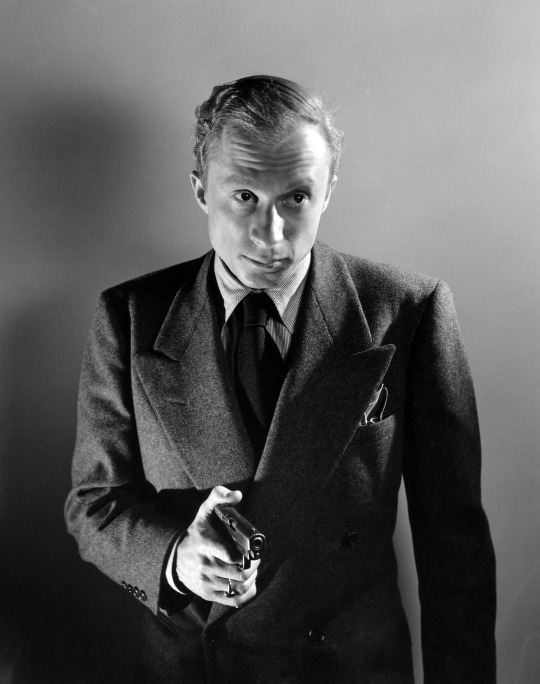
#Eva Marie Saint#Norman Lloyd#TCM#Turner Classic Movies#TCMFF#Film festival#blacklist#alfred hitchcock#old hollywood#Susan King
79 notes
·
View notes
Photo
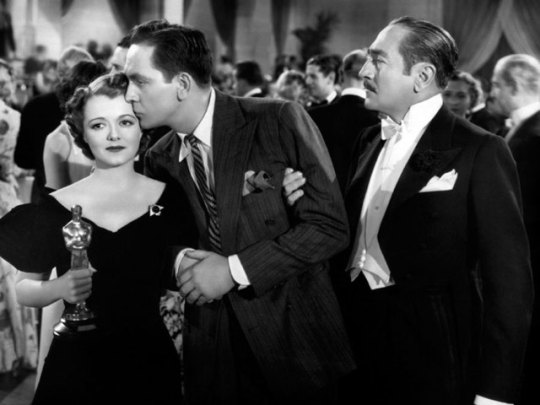
Janet Gaynor, Fredric March, Adolphe Menjou (L-R) in a scene from the drama film A Star Is Born, (USA, 1937, dir. William A. Wellman | United Artists), when Gaynor's film character (an actress named Vicki Lester) wins the Oscar for Best Actress.
Janet Gaynor, who had won the Best Actress Oscar in 1929, was herself nominated for the 1938 Academy Award for Best Actress for her performance as the Oscar-winning actress in A Star Is Born, but she lost to Luise Rainer. William A. Wellman and Robert Carson won the Academy Award for Best Original Story.
#Janet Gaynor#1937#actress#Fredric March#Adolphe Menjou#Oscars#film#film still#10th Academy Awards#Academy Awards#William A. Wellman#Robert Carson#United Artists#February Oscar month
5 notes
·
View notes